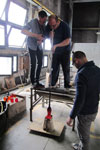BTM 01 / The Mould
BTM 01 / The Mould is a project that focuses on artistic glass made using moulds. We decided to focus on this topic because of the cultural relevance of this process in the context of the glass production in Murano, Venice.
For hundreds of years, up to a few decades ago, the mould has been the key device to produce objects in glass, especially everyday items. Making glass using a mould is certainly less spectacular than seeing a master blowing a piece by hand, but we believe it’s as interesting because of the narratives behind it. The mould implies a direct link to labour and to all the stories belonging to a unique context: it’s about the glorious and humble moments of the Venetian furnaces together.
A more practical reason for choosing the mould is to narrow the area of intervention and to act on a means that is more intuitive for a first approach to glass. Moreover, in a project where different personalities are involved, the concept of mould has been a good topic to start from and allows everyone express their best intuitions.
Finally, the mould has been the physical object that has helped us establish a connection with workers from the furnace; a place where unwritten rules regulate the dynamics of such a special place. Most of our energy went in trying to be accepted in the furnace and to gain the respect of people for whom glass is not just an experiment or a project, but is a devoted lifestyle.
—
All the materials used in Breaking the Mould / The Mould tests fulfill the requirements below:
1. BOTTOM-UP ENGINEERING PROCESS
Fibers’ ends designed microfusion with structural lattice elements compatibility between glass and new surfaces.
2. LINEAR THERMAL EXPANSION COEFFICIENTS DIFFERENCE
Δα = α2 – α1 = (x- 7.5)*10(-6) m/m K
with designed α values in order to obtain: -1.0 < Δα < 1.5
achieving a texturing shrinkage.
3. FIBER DIAMETERS AND MATERIALS NOT HEALTH-DANGEROUS
4. NOT-EXPLOSIVE PROCESSES
For immediate industrial production together with moulds multiple usage.
—
(a)
“[…] the mould can have circular or polygonal section, sometimes with textures or decorations that will be impressed onto the blown piece. […] Finally the moulded pieces can be hand-finished.”
form Glossario del Vetro Veneziano, curated by C. Moretti, Marsilio, Venice 2002.
(b)
Iron-cast moulds in an old furnace in Murano.
(c)
A moment of the making of Breaking the Mould.



